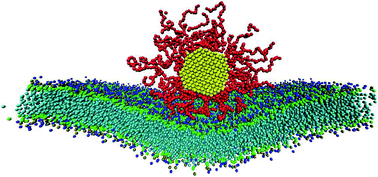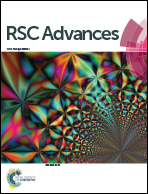Computational investigation of the influence of chain length on the shielding effect of PEGylated nanoparticles†
Abstract
Polyethylene glycol (PEG) has been heavily used as a building block in the design of stealth nanocarriers for drug delivery. Besides allowing a PEGylated particle to avoid opsonization by serum proteins, the shielding effect of grafted PEG molecules suppresses the nanoparticle (NP)-induced bending of the biomembrane. In this study, we investigated the influence of the chain length (molecular weight) of PEG molecules on the interaction between a PEGylated NP and the biomembrane, via coarse grained molecular dynamics simulations. The shielding effect of PEG molecules is affected by several factors, including the dynamics of PEG molecules attaching to the membrane, the conformational transition of these long chains and the improved surface elasticity of a PEGylated NP. Analysis of the structural variations and dynamic behavior of grafted PEG molecules indicates that the polymer chain length is a critical factor in improving the blocking characteristics of a PEGylated NP. In addition, the size of a NP also has an important influence, which should not be neglected in the design of stealth PEGylated nanocarriers. These findings are consistent with experimental results, and to some extent give a molecular level interpretation of some macro-scale observations of the prolonged circulation half-life of stealth nanocarriers.


 Please wait while we load your content...
Please wait while we load your content...